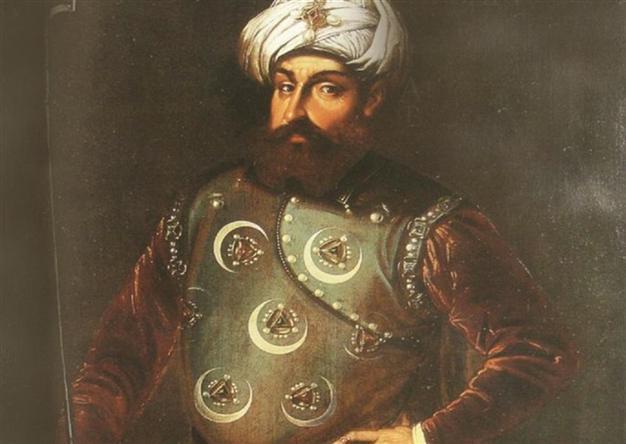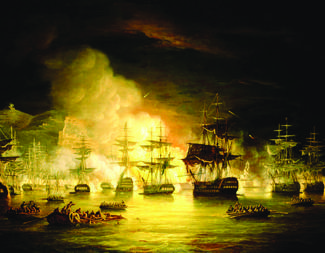The keys to Oran
NIKI GAMM ISTANBUL – Hürriyet Daily News

Oruç’s brother Hayreddin continued to reap the benefits from the allegiance with the Ottomans, although the Spaniards were able to recapture Algiers in 1519. Help could not arrive from the sultan in time.
14 December 1708. The keys to the city of Oran in Algeria were presented to Ottoman Sultan Ahmed III. The fortress which had been in Spanish hands until then had been conquered by the Governor-general of Algeria, Bektaş Hoca and it marked an end to Spain’s interest in Algeria for almost another hundred years. The event happened 305 years ago and by coincidence the Second Turkish Products Fair was held this past week in Algiers to encourage trade between Algeria and Turkey.The two countries have a history dating back to the 16th century - a history bound up with the Ottomans’ advance into the western Mediterranean and the name of the famous Hayreddin Barbarossa. The Spanish in particular were active in the western Mediterranean and had seized a number of ports along the North African coast in what is present day Algeria. At about the same time, around the year 1504, Oruç and his brother Hayreddin Barbarossa started harrowing Spanish and Italian shipping with two boats as privateers in the central Mediterranean. They used Tunis as their base and used the riches they had captured to increase their fleet of boats. Eventually they decided that the island of Djerba with its natural port would be a better place to spend the winter and to sail from during the rest of the year.
 In 1512 Oruç and his brother was offered by the exiled ruler of Bougie, which was fewer than a hundred miles from Algiers, the chance to join him in recapturing the city that was under Spanish control at the time. They captured Bougie. Four years later they received another offer – to join a nearby Arab ruler called Sheikh Selim in attacking Algiers. Oruç eliminated Selim and proclaimed himself sultan. During all of this, the two brothers had continued to challenge Spain and Spanish shipping more than any other country. In this they received the backing of the Moriscos, that is, the Moors whom the Spanish had driven out of their country in 1496. Not only did the Moriscos want revenge but there were enough of them who had remained in Spain after pretending to become Christian to provide Oruç and his brother with accurate information on what was happening.
In 1512 Oruç and his brother was offered by the exiled ruler of Bougie, which was fewer than a hundred miles from Algiers, the chance to join him in recapturing the city that was under Spanish control at the time. They captured Bougie. Four years later they received another offer – to join a nearby Arab ruler called Sheikh Selim in attacking Algiers. Oruç eliminated Selim and proclaimed himself sultan. During all of this, the two brothers had continued to challenge Spain and Spanish shipping more than any other country. In this they received the backing of the Moriscos, that is, the Moors whom the Spanish had driven out of their country in 1496. Not only did the Moriscos want revenge but there were enough of them who had remained in Spain after pretending to become Christian to provide Oruç and his brother with accurate information on what was happening. All this time however he had been clever enough to proclaim his allegiance to the Ottoman sultan and in 1517 Oruç received the title of Beylerbeyi or Governor General of the Maghreb as the province was called in those days from Sultan Selim I (r. 1512 – 1520). The sultan sent 2,000 Janissaries, artillery and 4,000 volunteers to assist Oruç Bey who, however, didn’t live long to enjoy his success as he was killed in battle in May 1518. (A census of Algeria taken in 1808 noted that there were 10,000 Turks living there and 5,000 of Turkish and Algerian descent. How many there are in today’s population is unclear. Estimates range from five percent to ten percent out of a total population of around 37 million.)
Oruç’s brother Hayreddin continued to reap the benefits from the allegiance with the Ottomans, although the Spaniards were able to recapture Algiers in 1519. Help could not arrive from the sultan in time. It took him until 1525 to take it back. In spite of Spanish efforts, Hayreddin and his ships were able to raid along the Italian and Spanish coasts, plundering and seizing slaves.
In 1533, Sultan Süleyman requested Hayreddin’s presence in Istanbul. He was to stay there until spring 1534 and leave as the head of the Ottoman fleet with the rank of vizier as befitted a member of the imperial council. He set his sights on conquering neighboring Tunisia and captured Tunis in that same year. The following year the Holy Roman Emperor Charles V himself led an expedition that resulted in Tunis’ recapture. The Spaniards then held on to the city until 1574 when the Ottomans retook the city for the last time.
The Spaniards continued to keep an interest in the Mediterranean area although their conquest of the Americas occupied more and more of their time and resources. Many of the cities along the North African coast remained in Spanish hands in spite of this. To counter the Spanish and secure privileges for its merchants, the French made an alliance with the Ottomans in 1536. Hayreddin Barbarossa even spent a winter in Toulon with the Ottoman fleet.
Barbarossa turned over the governor-generalship to his son when he retired in 1544. Hasan kept up the tradition of raiding the Italian coast and preying on Spanish ships. Battles occur back and forth on the sea and on land until the Spanish signed a peace treaty with the Ottomans in 1580. With it, Algeria became Ottoman territory and had to cease its attacks on Spanish shipping. The Ottomans then sent pashas for three-year terms to head the government in Algiers and consolidate the Empire’s power in the Maghreb.
The fate of Oran
When peace was signed between Spain and the Ottoman Empire, the Spaniards still held on to Oran and Mers el-Kebir in spite of all the efforts that the Ottomans had made to capture them. Even Barbarossa’s son Hasan made an attempt in 1562 but was thwarted when a fleet arrived to relieve the embattled cities. As a result the Spaniards continued to hold the cities until 1708 when the so-called War of the Spanish Succession (1701 - 1714) was going on. It is then that the keys of Oran were formally handed over to Sultan Ahmed III because it was a significant victory for the Ottomans.
However in 1732 the Spaniards again took it back and held it for nearly 60 years until an earthquake changed the mind of King Charles IV. More than 3,000 people died in the 1790 earthquake which occurred at a time when he had barely been on the throne two years. In any case he was far from wanting to engage in politics, preferring to hunt instead, so the decision seems to have been taken by his prime minister to arrange to hand Oran over to Algiers. A treaty was signed in 1792 only to be followed by another earthquake that damaged the city’s defenses. From then on, Oran, today the second largest city in Algeria, remained in Ottoman hands until the 19th century when the French conquered the country.
















